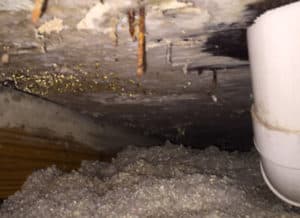Many homeowners are now facing the reality of mold in their attic.

What is causing it? To understand what may be causing problems you need to understand how your house breathes. Your roof breathes through intake and exhaust vents. Intake vents are usually positioned in your soffits, while exhaust venting is done through can vents, ridge vents or power vents.
Proper venting does three things:1. Removes moisture
2. Lowers the temperature of the roof deck to impede the degradation of roofing material and delaminating of decking material
3. Prevents the temperature rise of the attic space causing the snow to melt prematurely, thus forming ice dams.
Improper venting of the attic space will cause a build up of moisture. Mold requires chronic moisture to form and grow. Unless the roof is leaking, the most likely source of the moisture came from the living in the home. During the winter the house is closed up. This frequently leads to high moisture content from bathrooms, cooking and perspiration.
A quick check of you attic should show your bathroom and kitchen vent fans vented through a gable wall or the roof. They should not be vented into a soffit as that is the intake for the attic ventilation and the warm moist air will get sucked back into the attic. If the moisture gets pulled back into the attic it wets down the insulation causing more serious damage.
The moisture may be carried by escaping warm air into the attic through leaks. Some of the most common leaks are attic doors, recessed lighting, holes where pipes and wires run into the attic, or gaps around your chimney. In some homes a whole house fan is installed in a ceiling and is a source of heat and moisture to the attack. Your goal is to seal up all the holes and insulate to prevent heat loss and moisture to an attack.Evaluate the ventilation system. Is there adequate intake and exhaust venting? Your goal is to create 1 square foot (144 sq. inches) of intake and exhaust venting per 300 sq ft of attic floor space. Next, examine the exhaust vents to make sure you do not have two open systems. A common mistake is to leave a gable vent open while utilizing a ridge vent. They are not made to work together and will short circuit leading to little effective venting and thus moisture build up and mold. What happens is the ridge vent will suck air. It pulls it from the closest point, the open gable vent. This will not force the ridge vent to pull air from the soffit area as it was intended. The wet moist air stagnates in the soffit area wetting the insulation and forming mold.
When you are looking for a company to install your roof, make sure they do a professional attic inspection using the latest in equipment and technology. Professional roofing companies that install permanent metal roofs have for years understood the dangers of trapping moisture under a permanent roof. Installing a permanent metal roof does no good if the roof deck it is being installed is rotting.
Paying your attic a visit and inspecting the venting may be the best thing you do to save your home. Insurance companies long ago reduced their liability by reducing your insurance coverage to a fraction of the cost to abate mold.

.
Tags
Subscribe to American Metal Roofs's Blog


Comments
Molds are lovers of all places full of moisture. You would especially hate them if your house is made of wood because they rot wood through and destroy a house's framework. This blog is very helpful in getting to the root of the problem. Your detailed explanation on how ventilation is the solution to preventing mold accumulation in the home. Well done.